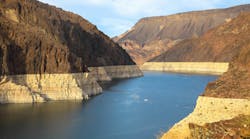Could Flint Happen Again? The Road Salt Connection

Most of us have been following the story of Flint, Michigan’s water supply. What happened—and continues to happen—in Flint is tragic, but it might not be an isolated case.
Here’s a brief recap of the situation: In 2013 Flint decided to stop buying its drinking water from Detroit and instead get it more cheaply via a new pipeline from Lake Huron (which is also the source of Detroit’s water). Because the new pipeline wouldn’t be completed for three years, however, and because Detroit said it would stop selling water to Flint in early 2014, Flint decided to temporarily take its drinking water from the Flint River. In an unintentionally prescient comment at the changeover ceremony, where officials toasted with glasses of river water, Flint’s mayor (now former mayor) Dayne Walling observed, “The water quality speaks for itself.”
Most of us have been following the story of Flint, Michigan’s water supply. What happened—and continues to happen—in Flint is tragic, but it might not be an isolated case. Here’s a brief recap of the situation: In 2013 Flint decided to stop buying its drinking water from Detroit and instead get it more cheaply via a new pipeline from Lake Huron (which is also the source of Detroit’s water). Because the new pipeline wouldn’t be completed for three years, however, and because Detroit said it would stop selling water to Flint in early 2014, Flint decided to temporarily take its drinking water from the Flint River. In an unintentionally prescient comment at the changeover ceremony, where officials toasted with glasses of river water, Flint’s mayor (now former mayor) Dayne Walling observed, “The water quality speaks for itself.” [text_ad] Now, as we all know, levels of lead in the water reaching Flint’s residents are dangerously high. The lead is leaching from the city’s aging pipes. An anti-corrosion agent like orthophosphate could have been added to the water to prevent or at least reduce the problem—and why that wasn’t done should be the subject of a much longer piece. But the question is, what caused the water from the Flint River to be so corrosive in the first place? Flint’s pipes are probably not very different from pipes in many American cities, particularly older cities. According to Plumbing Manufacturers International, most homes built before 1980 have lead solder connecting the copper pipes, and many US cities have all-lead pipes running from the utilities to individual homes or businesses. Although an oxidation layer develops on the pipes over time to prevent leaching—and water utilities can add various substances to help create and maintain that barrier—changes in chemistry can damage or destroy the oxidation layer. That’s exactly what happened in Flint when it suddenly began drawing water from the Flint River. The river water had a number of other problems as well; tests have shown it contained E. coli bacteria and high levels of trihalomethanes from disinfectants. But one of the likely culprits that made the water corrosive is chloride ions—which got there through years of applying salt to icy winter roads. According to this article, water from the Flint River is 19 times more corrosive than the previously used water from Lake Huron. (The article also explains how corrosivity can increase bacteria levels in the water.) One step we can take to reduce the likelihood of this situation happening elsewhere is to limit the chloride—the road salt—entering surface waters in the first place. Although we can’t eliminate it entirely, several articles in Stormwater have explored ways to reduce it. This article from 2009 looks at, among other things, chloride TMDLs in several communities. A two-part article from 2012 looks at techniques and training programs to help cities achieve the same safety results with less salt. In the meantime, though, there are no easy answers in Flint. Simply replacing the pipes might seem like an obvious solution, but it’s prohibitively expensive. Estimates for replacing the city’s water pipes range from $700 million to $1.5 billion. One Flint family got an estimate from a plumber for replacing the service line—the pipe that brings water from the water utility’s lines into their home—and the pipes within the walls of the house itself. The service line is lead, and the pipes in the walls are copper with lead solder. Replacing all of them would cost about $10,000, the plumber said; the home itself is worth, at most, $18,000.Now, as we all know, levels of lead in the water reaching Flint’s residents are dangerously high. The lead is leaching from the city’s aging pipes. An anti-corrosion agent like orthophosphate could have been added to the water to prevent or at least reduce the problem—and why that wasn’t done should be the subject of a much longer piece. But the question is, what caused the water from the Flint River to be so corrosive in the first place?
Flint’s pipes are probably not very different from pipes in many American cities, particularly older cities. According to Plumbing Manufacturers International, most homes built before 1980 have lead solder connecting the copper pipes, and many US cities have all-lead pipes running from the utilities to individual homes or businesses. Although an oxidation layer develops on the pipes over time to prevent leaching—and water utilities can add various substances to help create and maintain that barrier—changes in chemistry can damage or destroy the oxidation layer.
That’s exactly what happened in Flint when it suddenly began drawing water from the Flint River. The river water had a number of other problems as well; tests have shown it contained E. coli bacteria and high levels of trihalomethanes from disinfectants. But one of the likely culprits that made the water corrosive is chloride ions—which got there through years of applying salt to icy winter roads. According to this article, water from the Flint River is 19 times more corrosive than the previously used water from Lake Huron. (The article also explains how corrosivity can increase bacteria levels in the water.)
One step we can take to reduce the likelihood of this situation happening elsewhere is to limit the chloride—the road salt—entering surface waters in the first place. Although we can’t eliminate it entirely, several articles in Stormwater have explored ways to reduce it. This article from 2009 looks at, among other things, chloride TMDLs in several communities. A two-part article from 2012 looks at techniques and training programs to help cities achieve the same safety results with less salt.
In the meantime, though, there are no easy answers in Flint. Simply replacing the pipes might seem like an obvious solution, but it’s prohibitively expensive. Estimates for replacing the city’s water pipes range from $700 million to $1.5 billion. One Flint family got an estimate from a plumber for replacing the service line—the pipe that brings water from the water utility’s lines into their home—and the pipes within the walls of the house itself. The service line is lead, and the pipes in the walls are copper with lead solder. Replacing all of them would cost about $10,000, the plumber said; the home itself is worth, at most, $18,000.About the Author
Janice Kaspersen
Janice Kaspersen is the former editor of Erosion Control and Stormwater magazines.


